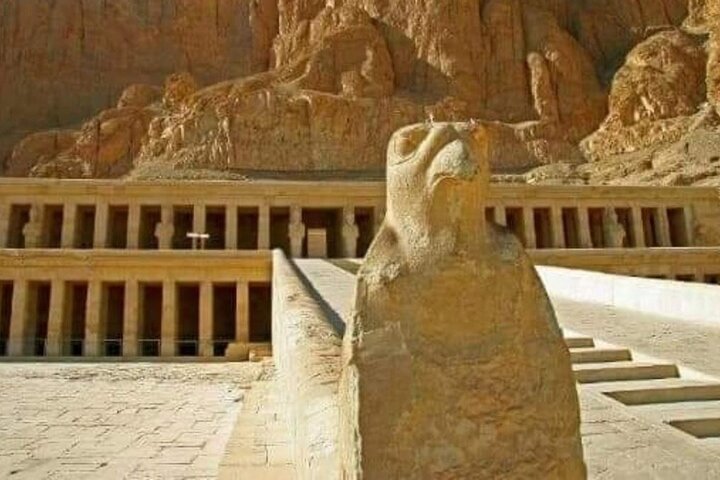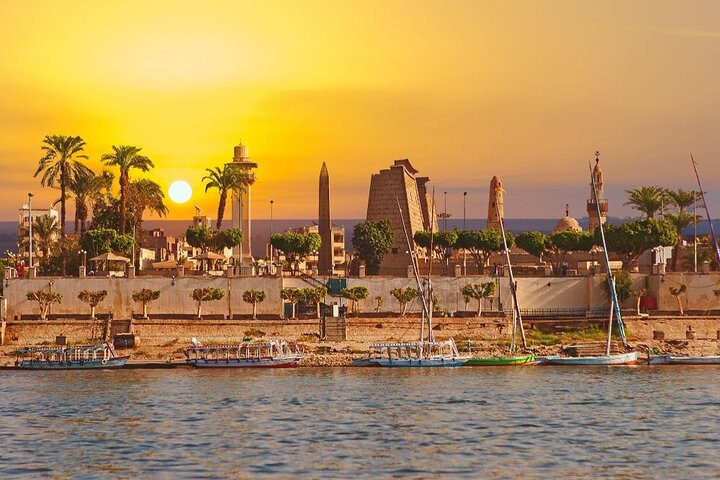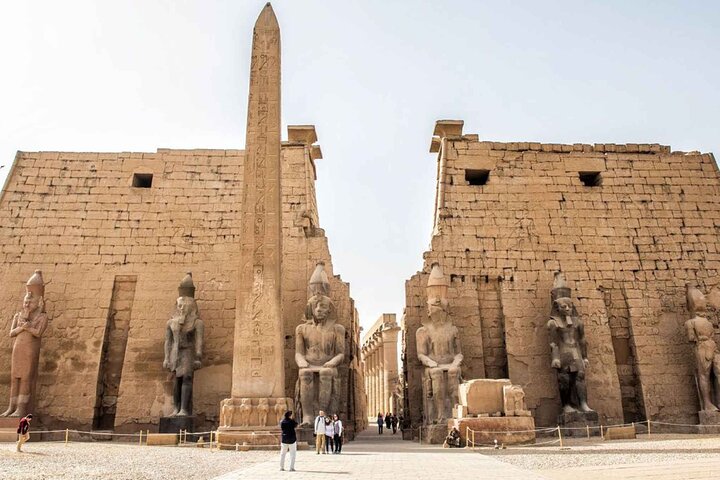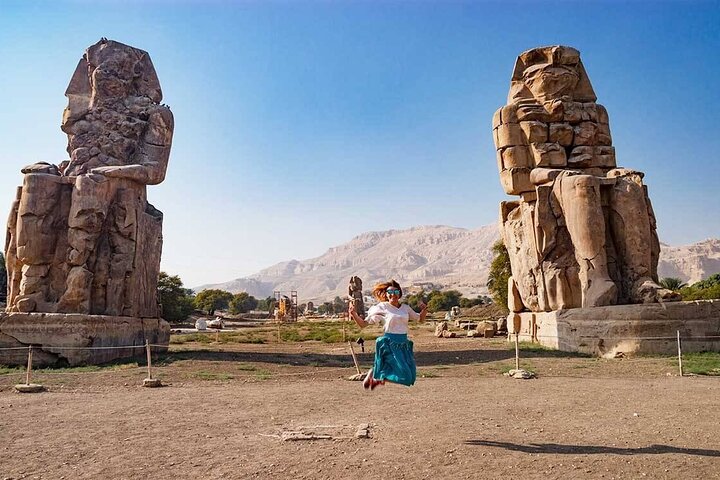Fabulous 5-Days Tour around Cairo, Luxor and Alexandria from Cairo by flight
Share this tour

Offered languages
- German
- German
- German
- English
- English
- English
- Italian
- Italian
- Italian
- French
- French
- French
- Spanish
- Spanish
- Spanish
Discover the best places in Cairo, Luxor and Alexandria. Cairo has many historical places you can't miss, such as the pyramids, the Egyptian Museum, Coptic Cairo and Islamic Cairo. Also visit The ancien capital of Egypt; Luxor with its great temples and tombs, the lovely city of Alexandria, located north of Cairo.
Highlights
Travel back in time to historic Cairo, Luxor, and Alexandria
Get personalized insights into the ancient world from your private guide
Savor four gourmet lunches in top-notch restaurants
Take it easy with daily private transfers to and from your Cairo hotel
What's Included
Lunch
Breakfast
Meeting and pickup
we pick up all travelers from any hotel in Cairo or Giza or Cairo International Airport
Itinerary
-
1Cairo
Pick Up From The Hotels Or Cairo International Airport then Transfer You To The Accommodation Hotel In Cairo Or Giza
Admission ticket free -
2The Egyptian Museum in Cairo
The Egyptian Museum is one of the largest and most famous museums in the world. It is located in the heart of the Egyptian capital "Cairo" on the northern side of Tahrir Square. Its establishment dates back to 1835 and was located at the time in Al-Azbakeya Park, where at that time it contained a large number of various monuments, The Egyptian Museum is considered one of the first museums in the world that was established to be a public museum, unlike the museums that preceded it. The museum includes more than 180,000 artifacts, the most important of which are the archaeological collections that were found in the tombs of the kings and the royal entourage of the middle family in Dahshur in 1894, and the museum now includes the greatest collection Archeology in the world expressing all stages of ancient Egyptian history.
2 hours • Admission ticket not included -
3Pyramids of Giza
The Giza pyramids are located on the Giza plateau in the Giza governorate on the west bank of the Nile. It was built about 25 centuries BC, between 2480 and 2550 BC. It includes three pyramids: Khufu, Khafre and Menkaure. And the pyramids, according to one of the hypotheses, are royal tombs, each bearing the name of the king who built it and was buried in it, and the pyramid construction here is a stage of the development of tomb architecture in ancient Egypt. It started with a small pit that turned into an underground room and then into several rooms topped by a terrace. After that, it developed to take the form of a listed pyramid at the hands of the engineer Imhotep, the minister of the Pharaoh, and King Djoser in the third dynasty. This was followed by two attempts by King Senefru, founder of the Fourth Dynasty
1 hour 30 minutes • Admission ticket not included -
4The Sphinx of Memphis
The Sphinx is a statue of a mythical creature with the body of a lion and the head of a human being carved from limestone, and it is likely that it was originally covered with a layer of plaster and colored, and traces of the original colors are still visible next to one of his ears. Located on the Giza Plateau on the west bank of the Nile in Giza, Egypt, the Sphinx is also the guardian of the plateau. It is the oldest known colossal carvings. Its length is about 73.5 meters, including 15 meters long for its front feet, its width is 19.3 meters, and its highest height from the ground is about 20 meters to the top of the head. It is believed that the ancient Egyptians built it during the reign of King Khafre (2558 BC-2532 BC), the builder of the second pyramid in Giza.
1 hour • Admission ticket not included -
5Luxor
Fly in the early morning to Luxor to visit the Temple of Karnak, the Temple of Luxor, Valley of the Kings, Temple of Hatshepsut and colssi of Memnon. Lunch is included at a good quality restaurant. At the end of the tour you will fly back to Cairo
Admission ticket free -
6Valley of the Kings
The Valley of the Kings, also known as "The Valley of the Kings", is a valley in Egypt that was used for 500 years during the period between the sixteenth and eleventh centuries BC to construct tombs for the pharaohs and nobles of the modern state extending during the eighteenth dynasties to the twentieth dynasty in ancient Egypt. The valley on the west bank of the Nile River facing Thebes (Luxor now) in the heart of the ancient funerary city of Thebes. The Valley of the Kings is divided into two valleys; The Eastern Valley (where most of the royal tombs are located) and the Western Valley. And with the discovery of the last burial chamber in 2006, known as (Cemetery 63), in addition to the discovery of two other entrances to the same chamber during 2008.
1 hour 30 minutes • Admission ticket not included -
7Temple of Hatshepsut at Deir el Bahari
The Temple of Hatshepsut or the mortuary temple of Hatshepsut is a temple from the Eighteenth Dynasty of Egypt, and the best remaining temples were built about 3500 years ago in Deir el-Bahari, Egypt. It was built by Queen Hatshepsut on the west bank of the Nile opposite to Thebes (the capital of ancient Egypt and the seat of the Amun worship) (Luxor today). The Temple of Hatshepsut is distinguished by its unique architectural design, in comparison to the Egyptian temples that were built on the eastern bank of the Nile at Thebes. The temple consists of three successive floors with open terraces. The temple was built of limestone, and in front of the second floor columns were erected limestone statues of the god Osiris and Queen Hatshepsut in a beautiful distribution. Originally, those statues were colored, and now only some monuments remain of the colors, and some statues are in very good condition, indicating the elegance and beauty of the temple's design.
1 hour • Admission ticket not included -
8Colossi of Memnon
Colossus of Memnon, known locally as (Al-Kulsat or Salamat), is two huge statues, built around the year 1350 BC, which are all that remains of a temple built in memory of Pharaoh Amenhotep III, who ruled Egypt during the eighteenth dynasty, located in the funeral city of Thebes Located west of the Nile in the present-day city of Luxor, the two identical statues depict Amenhotep III (14th century BC) seated, hands spread on his knees and looking eastward (in fact toward the southeast in modern directions) toward the river. Two short figures are carved on the front of the throne, along with his legs: his wife Tiye and his mother Death M and Ya. The side panels depict the Nile god Habi. The statues were made from blocks of quartzite sandstone that were quarried from Jabal al-Ahmar (near present-day Cairo) and transported 675 km (420 mi) overland to Thebes (Luxor).
30 minutes • Admission ticket free -
9Temple of Karnak
Karnak, or the Karnak Temple Complex, which is known as the Karnak Temple, is a group of temples, buildings and columns, where the expansion and construction processes continued since the Pharaonic era, specifically the kings of the Middle Kingdom, until the Roman era in Luxor in Egypt on the eastern coast. The temple was built for the divine triad Amun (Amun Ra in the modern era), his wife the goddess Mut and their son the god Khonsu; And each of them has a temple belonging to the Karnak Temples Complex. The temple was named with this name in relation to the city of Karnak, and it is a modern name that is distorted from the Arabic word Khurang, meaning the fortified village, which was given to many temples in the area during this period. While the temple was known in the beginning as "Bar Amun", meaning the temple of Amun or Betamun, and during the Middle Kingdom it was called the name Ibt Sut, which means the most chosen of places (sometimes translated as the chosen spot)
2 hours • Admission ticket not included -
10Luxor Temple
The Luxor Temple is a large complex of ancient Egyptian temples located on the eastern bank of the Nile River in the city of Luxor today known as (Thebes ancient). Founded in 1400 BC. The Luxor Temple was built to worship Amun-Ra, his wife Mut, and their son Khonsu. They are the gods, which are also called the Theban Triad (Theban Triad). Luxor Temple was built during the reign of the kings of the Eighteenth Dynasty and the Nineteenth Dynasty. The most important buildings in the temple are those that were built by Kings Amenhotep III (1397-1360 BC) and Ramses II (1290-1223 BC) (who added to the temple the open courtyard, the edifice, and the obelisks). Also, King Thutmose III (1490-1436 BC) set up shrines for visitors of the holy Theban Triad.
1 hour • Admission ticket not included -
11City Centre Alexandria
Alexandria is the second capital of Egypt, and its capital was in the past. It is the capital of the Alexandria Governorate and its largest city. It is located on the Mediterranean coast with a length of about 55 km northwest of the Nile Delta.Work on the establishment of Alexandria began at the hands of Alexander the Great in 332 BC by filling a part of the water separating an island extending in front of the main coast called "Pharos".And there is the Library of Alexandria and the Temple of Caesarion Anfushi Cemetery Tombs of Mustafa Kamel Tomb of Antoninus and Cleopatra The Sunken Museum (Alexandria) Greco-Roman Museum Museums of the New Library of Alexandria Aquarium Museum Old Alexandria Museum Bey Citadel Asheran column After Alexander the Great entered Egypt and expelled the Persians from it, the Egyptians welcomed him due to the cruelty with which they were treated under the Persian occupation
8 hours • Admission ticket not included -
12Cairo
End of service and departure - and transfer Cairo airport or Cairo Train Station Or any hotel in Cairo
Admission ticket free
Arrival To Cairo & Check-In at Hotel In Cairo
Giza Pyramids, mystical Sphinx , Saqqara and Egyptian Museum
Fly to luxor to visit Temple of Karnak, Temple of Luxor, Valley of the Kings, Temple of Hatshepsut and colssi of Memnon
Alexandria Library, Quitbay Fortress , Catacomb Tomb and Pompey's Pillar.
End Of Service
Additional info
- Specialized infant seats are available
- Public transportation options are available nearby
- Infants and small children can ride in a pram or stroller
- All areas and surfaces are wheelchair accessible
- Transportation options are wheelchair accessible
- Suitable for all physical fitness levels
Show 1 more
Additional info
- Specialized infant seats are available
- Public transportation options are available nearby
- Infants and small children can ride in a pram or stroller
- All areas and surfaces are wheelchair accessible
- Transportation options are wheelchair accessible
- Suitable for all physical fitness levels
- Wheelchair accessible
Tags
Cancellation Policy
For a full refund, cancel at least 24 hours before the scheduled departure time.
Show more
Cancellation Policy
- For a full refund, you must cancel at least 24 hours before the experience’s start time.
- If you cancel less than 24 hours before the experience’s start time, the amount you paid will not be refunded.
- Any changes made less than 24 hours before the experience’s start time will not be accepted.
- This experience requires a minimum number of travelers. If it’s canceled because the minimum isn’t met, you’ll be offered a different date/experience or a full refund.
You can cancel up to 24 hours in advance of the experience for a full refund.
Your guide to the flawless travel experience






















